You searched for: nazi germany
<< Previous | Displaying results 851-900 of 1274 for "nazi germany" | Next >>
-
Gertrud Teppich
ID CardGertrud, born Gertrud Herz, was one of three children born to a Jewish family in the German capital of Berlin. In her early twenties, Gertrud married Richard Teppich and the couple had two daughters. Richard owned and operated a dry-cleaning business. 1933-39: When Gertrud's husband died in 1931 she stayed on in their Berlin apartment. In 1938, five years after the Nazis came to power, Gertrud's oldest daughter, Ilse, and her family fled to Amsterdam. A year later her youngest daughter was able to leave…
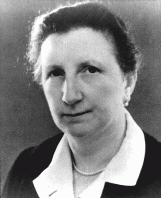
-
Rescue and Resistance
ArticleWhile some European Jews survived the Holocaust by hiding or escaping, others were rescued by non-Jews. Learn more about these acts of resistance.

-
Henry Morgenthau Jr.
ArticleHenry Morgenthau Jr had a key role in creating and operating the War Refugee Board, a government agency tasked with rescuing and providing relief for Jews during the Holocaust.
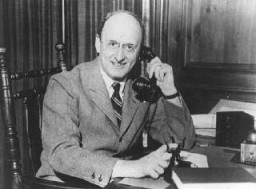
-
Presenting the prosecution's case at the International Military Tribunal
PhotoUS Major Frank B. Wallis (standing center), a member of the trial legal staff, presents the prosecution's case to the International Military Tribunal at Nuremberg. A chart (top left) shows where the defendants (bottom left) fit into the organizational scheme of the Nazi Party. At right are lawyers for the four prosecuting countries. Nuremberg, Germany, November 22, 1945. The trials of leading German officials before the International Military Tribunal are the best known of the postwar war crimes trials.…
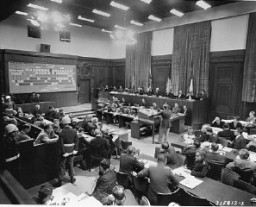
-
Portrait of Herschel Grynszpan
PhotoPortrait of Herschel Grynszpan taken after his arrest by French authorities for the assassination of German diplomat Ernst vom Rath. Grynszpan (1921-1943?). Born in Hannover, Germany, was the son of Polish Jews who had immigrated to Germany. In 1936 Grynszpan fled to Paris. On November 7, 1938, after having learned of the expulsion of his parents from Germany to Zbaszyn the Polish frontier, Grynszpan assassinated Ernst vom Rath, the third secretary of the German embassy in Paris. The diplomat's…
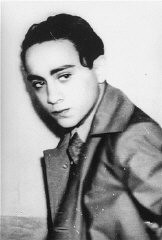
-
The Hadamar Trial
ArticleThe Hadamar Trial of October 1945 was the first mass atrocity trial held in the US occupation zone of Germany following World War II.

-
The Holocaust in Slovakia
ArticleLearn more about Slovakia during World War II, its alliance with Nazi Germany, and its involvement in the Holocaust.
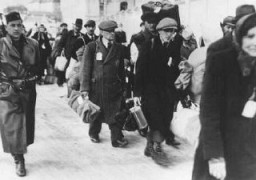
-
Dora-Mittelbau: Overview
ArticleOriginally a subcamp of Buchenwald, Dora-Mittelbau became the center of an extensive network of forced-labor camps for the production of V-2 missiles and other weapons.

-
Sachsenhausen: Liberation and Postwar Trials
ArticleLearn about the death march of prisoners from the Sachsenhausen camp, liberation of the remaining prisoners, and postwar trials of camp staff.

-
The 80th Infantry Division during World War II
ArticleThe 80th Infantry Division participated in major WWII campaigns and is recognized for liberating Buchenwald and the Ebensee subcamp of Mauthausen in 1945.
-
Martin Weiss
ID CardMartin was one of nine children born to orthodox Jewish parents in Veľká Poľana, a rural village in the Carpathian Mountains. His father owned a farm and a meat business, and his mother attended to the children and the home. Everyone in the family helped take care of the horses and cows. 1933–39: Martin attended the village's Czechoslovak schools, which were quite progressive. Like many of the other children, he looked forward to leaving the provincial life in Veľká Poľana. In 1938–1939, his…

-
Francis Ofner
ID CardFrancis grew up in a city with a Jewish community of 5,000. The Ofners belonged to a synagogue that sponsored many social activities, from sports to care for the elderly. In 1931 Francis began law school at the University of Zagreb. While a student, he organized a service that posted on university bulletin boards the translations of speeches by Nazi leaders broadcast on the radio. 1933-39: By the time Hitler became chancellor of Germany, Francis was heavily involved in trying to unify the university's…
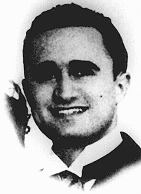
-
Romania
ArticleEven before joining the Axis alliance in 1940, Romania had a history of antisemitic persecution. Learn more about Romania before and during World War II.

-
Blood Libel
ArticleBlood libels were false allegations that Jews used the blood of non-Jewish children in rituals. Nazi propagandists used this false charge in their antisemitic propaganda.

-
World War II in Europe
ArticleWorld War II lasted from 1939 to 1945, when the Allies defeated the Axis powers. Learn about key invasions and events during WWII, also known as the Second World War.
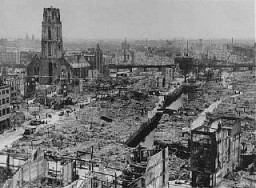
-
Gisella Renate Berg
ID CardGisella lived with her parents, grandparents, uncle, and older sister, Inge, in Lechenich, a small village outside of Cologne. The Bergs were an observant Jewish family. Gisella's grandfather was the president of the local synagogue association and her uncle was the cantor. Her father, Josef was a respected cattle dealer, who had many business and personal contacts with their Jewish and non-Jewish neighbors. 1933–39: Gisella was born several months after the Nazis came to power. Her parents feared for…
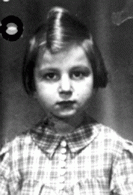
-
Auschwitz
Animated MapView an animated map showing key events in the history of the Auschwitz camp complex in German-occupied Poland.

-
Ben Ferencz and the Fight for International Justice
ArticleBen Ferencz investigated and prosecuted Nazi crimes and devoted his career to creating an international system of justice. Learn about his activities and impact.

-
Peter Philipps
ID CardPete grew up in Essen, a major industrial city on Germany's Ruhr River. His father worked as a cattle hide dealer for an international trading company in nearby Muehlheim. His mother was a designer for a fashionable women's dress shop. Pete, his younger twin brothers, and parents lived together in an apartment. 1933–39: Pete had barely passed his first birthday when the Nazis came to power. His father realized the danger that now faced Jews in Germany, and the family left for Prague, Czechoslovakia, in…
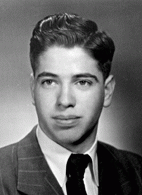
-
Freemasonry
ArticleAdolf Hitler repeated the pre-existing claim that Jews used Freemasonry to achieve their political ends. Learn more about the history of Freemasonry.
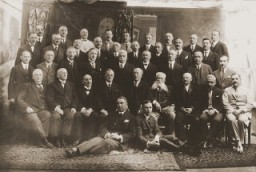
-
The Great Depression
ArticleLearn about causes, scope, and impacts of the Great Depression, including how it played a role in Adolf Hitler's emergence as a viable political leader in Germany.
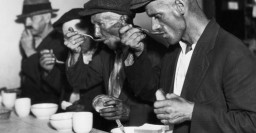
-
Janka Glueck Gruenberger
ID CardJanka was one of seven children raised in a Yiddish-and Hungarian-speaking household by religious Jewish parents in the city of Kosice. In 1918, when she was 20 years old, Kosice changed from Hungarian to Czechoslovak rule. Three years later, Janka married Ludovit Gruenberger, and their three children were born Czech citizens. 1933-39: Janka was an accomplished milliner, and she helped her husband run a tailoring business from their apartment. Like many Jews in Kosice, Janka and Ludovit were upset when…
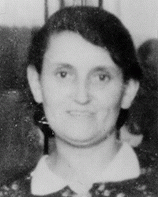
-
Annexation of Austria: The Anschluss
FilmIn an attempt to prevent the German annexation of Austria, Austrian chancellor Kurt von Schuschnigg called a plebiscite (referendum) on Austrian independence. On March 11, 1938, the Germans pressured Schuschnigg to cancel the plebiscite and resign. This German newsreel footage from March and April 1938 served as propaganda for the Nazi annexation of Austria. It begins with images of pro-Nazi residents in Graz expressing their opposition to Schuschnigg's plebiscite. It also includes footage after…
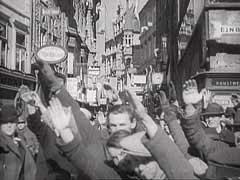
-
Vidkun Quisling on Trial in Norway for War Crimes
FilmVidkun Quisling headed the German-controlled government of Norway from 1942-1945. Because of his actions, his name became synonymous with Nazi collaboration.
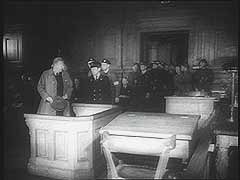
-
Theresienstadt: Establishment
ArticleLearn about the establishment of the Theresienstadt camp/ghetto, which served multiple purposes from 1941-45 and had an important propaganda function for the Germans.

-
The War Refugee Board
ArticleThe War Refugee Board was formed in 1944 by executive order under President Roosevelt. It was tasked with the rescue and relief of victims of Nazi oppression.

-
The 84th Infantry Division during World War II
ArticleThe 84th Infantry Division participated in major WWII campaigns and is recognized for liberating two Neuengamme subcamps, Hannover-Ahlem and Salzwedel, in 1945.
-
War Refugee Board: Activities - Photographs
Media EssayOn January 22, 1944, President Franklin D. Roosevelt announced a new policy to rescue and provide relief for Jews and other groups persecuted by Nazi Germany and its collaborators. The War Refugee Board, tasked with carrying out these programs, likely saved tens of thousands of lives. The War Refugee Board was the first and only official American response to the crimes we now call the Holocaust.
-
"Web of Communications" chart, July 1940
DocumentDiagram showing "the web of communications" between Japanese diplomats and members of the Polish resistance in the Baltic states and Scandinavia. The "Konsulat japonski Kowno" refers to Sugihara. Despite its ties with Nazi Germany, Japan pursued its own course in foreign policy. After the Germans occupied Poland and the Netherlands, Japan continued relations with both the Polish and Dutch governments-in-exile in London. July 1940.

-
Camp System: Maps
Media EssayBetween 1933 and 1945, Nazi Germany and its allies established more than 42,000 camps and othe...
-
Annexation of Austria
FilmGerman troops entered Austria on March 12, 1938. The annexation of Austria to Germany was proclaimed on March 13, 1938. In this German newsreel footage, Austrians express overwhelming enthusiasm for the Nazi takeover of their country.
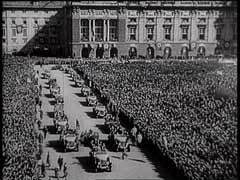
-
Close-up of corpses in the crematorium mortuary in Dachau
PhotoClose-up of corpses piled in the crematorium mortuary in the newly liberated Dachau concentration camp. Dachau, Germany, May 1945. This image is among the commonly reproduced and distributed, and often extremely graphic, images of liberation. These photographs provided powerful documentation of the crimes of the Nazi era.
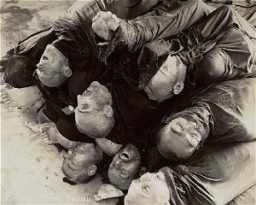
-
Bodies of victims in the Nordhausen camp
PhotoView of the main street of the Nordhausen concentration camp, outside of the central barracks (Boelke Kaserne), where the bodies of prisoners have been laid out in long rows. Nordhausen, Germany, April 13–14, 1945. This image is among the commonly reproduced and distributed, and often extremely graphic, images of liberation. These photographs provided powerful documentation of the crimes of the Nazi era.
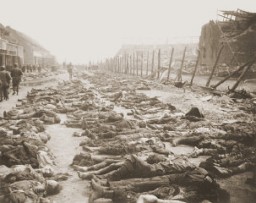
-
Bodies of victims outside the crematorium in Buchenwald
PhotoThe bodies of former prisoners are stacked outside the crematorium in the newly liberated Buchenwald concentration camp. Buchenwald, Germany, April 23, 1945. This image is among the commonly reproduced and distributed, and often extremely graphic, images of liberation. These photographs provided powerful documentation of the crimes of the Nazi era.

-
The charred corpse of a prisoner killed near Gardelegen
PhotoThe charred corpse of a prisoner killed by the SS in a barn just outside of Gardelegen. The SS guards locked the prisoners, who were on a death march from the Dora-Mittelbau camp, in a barn, which was then set ablaze. Gardelegen, Germany, April 16, 1945. This image is among the commonly reproduced and distributed, and often extremely graphic, images of liberation. These photographs provided powerful documentation of the crimes of the Nazi era.
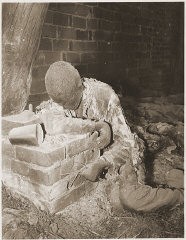
-
The charred remains of former prisoners in two crematoria ovens in the newly liberated Buchenwald concentration camp.
PhotoThe charred remains of former prisoners in two crematoria ovens in the newly liberated Buchenwald concentration camp. Buchenwald, Germany, April 14, 1945. This image is among the commonly reproduced and distributed, and often extremely graphic, images of liberation. These photographs provided powerful documentation of the crimes of the Nazi era.
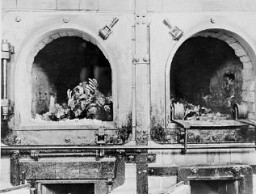
-
Bodies outside the crematorium at Dachau
PhotoThe bodies of former prisoners are piled outside the crematorium at the newly liberated Dachau concentration camp. Dachau, Germany, April–May 1945. This image is among the commonly reproduced and distributed, and often extremely graphic, images of liberation. These photographs provided powerful documentation of the crimes of the Nazi era.

-
Two survivors prepare food outside barracks in Dachau
PhotoTwo survivors prepare food outside the barracks in Dachau, Germany, May 1945. This image is among the commonly reproduced and distributed images of liberation. These photographs provided powerful documentation of the crimes of the Nazi era.

-
US Army soldier views the cemetery at Hadamar
PhotoA US Army soldier views the cemetery at Hadamar, where victims of the Nazi euthanasia program were buried in mass graves. This photograph was taken by an American military photographer soon after the liberation. Germany, April 5, 1945.

-
One of the railcars of the Dachau death train
PhotoCorpses lie in one of the open railcars of the Dachau death train. The Dachau death train consisted of nearly forty cars containing the bodies of between two and three thousand prisoners transported to Dachau in the last days of the war. Dachau, Germany, April 29, 1945. This image is among the commonly reproduced and distributed, and often extremely graphic, images of liberation. These photographs provided powerful documentation of the crimes of the Nazi era.
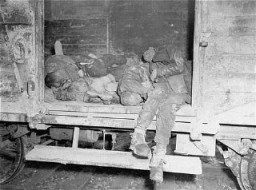
-
Bodies in the Dachau crematorium mortuary
PhotoThe bodies of former prisoners are piled in the crematorium mortuary in the newly liberated Dachau concentration camp. Dachau, Germany, April 29, 1945. This image is among the commonly reproduced and distributed, and often extremely graphic, images of liberation. These photographs provided powerful documentation of the crimes of the Nazi era.

-
Demonstrating the operation of the Dachau crematorium
PhotoSurvivors of the Dachau concentration camp demonstrate the operation of the crematorium by pushing a corpse into one of the ovens. Dachau, Germany, April 29–May 10, 1945. This image is among the commonly reproduced and distributed, and often extremely graphic, images of liberation. These photographs provided powerful documentation of the crimes of the Nazi era.
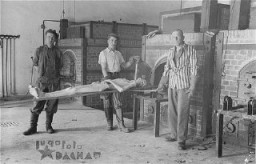
-
Demonstrating the operation of the Dachau crematorium
PhotoSurvivors of the Dachau concentration camp demonstrate the operation of the crematorium by preparing a corpse to be placed into one of the ovens. Dachau, Germany, April 29–May 10, 1945. This image is among the commonly reproduced and distributed, and often extremely graphic, images of liberation. These photographs provided powerful documentation of the crimes of the Nazi era.
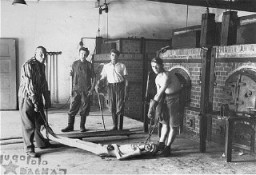
-
Demonstrating the operation of the Dachau crematorium
PhotoSurvivors of the Dachau concentration camp demonstrate the operation of the crematorium by dragging a corpse toward one of the ovens. Dachau, Germany, April 29–May 10, 1945. This image is among the commonly reproduced and distributed, and often extremely graphic, images of liberation. These photographs provided powerful documentation of the crimes of the Nazi era.
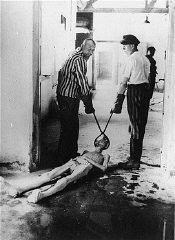
-
German civilians remove the bodies of prisoners killed in the Nordhausen camp
PhotoGerman civilians remove the bodies of prisoners killed in the Nordhausen concentration camp and lay them out in long rows outside the central barracks (Boelke Kaserne). Nordhausen, Germany, April 12, 1945. This image is among the commonly reproduced and distributed, and often extremely graphic, images of liberation. These photographs provided powerful documentation of the crimes of the Nazi era.
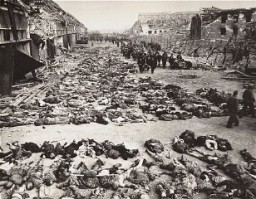
-
Corpses in the crematorium mortuary at Dachau
PhotoCorpses are piled in the crematorium mortuary in the newly liberated Dachau concentration camp. Dachau, Germany, May 1945. This image is among the commonly reproduced and distributed, and often extremely graphic, images of liberation. These photographs provided powerful documentation of the crimes of the Nazi era.
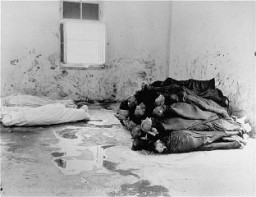
-
A witness testifies about the murder of Catholic priests at Dachau
PhotoFriedrich Hoffman, holding a stack of death records, testifies about the murder of 324 Catholic priests who were exposed to malaria during Nazi medical experiments at the Dachau concentration camp. Dachau, Germany, November 22, 1945.
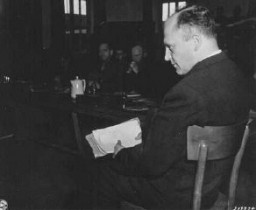
-
Germans gather around books they regard as "un-German"
PhotoGermans crowd around a truck filled with "un-German" books, confiscated from the library of the Institute for Sexual Science, for burning by the Nazis. The books were publically burned at Berlin's Opernplatz (Opera Square). Berlin, Germany, May 10, 1933.
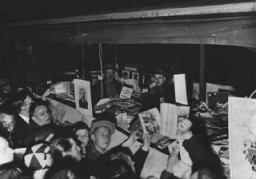
-
A crowd cheers Hitler in Vienna
PhotoA cheering crowd greets Adolf Hitler as he enters Vienna. Austria, March 1938. After a prolonged period of economic stagnation, political dictatorship, and intense Nazi propaganda inside Austria, German troops entered the country on March 12, 1938. They received the enthusiastic support of most of the population. Austria was incorporated into Germany the next day.

-
Personnel of T4
PhotoPersonnel of T4, the agency created to administer the Nazi Euthanasia Program. Pictured from left to right are: Erich Bauer (chauffeur), Dr. Rudolf Lonauer, Dr. Victor Ratka, Dr. Friedrich Mennecke, Dr. Paul Nitsche,and Dr. Gerhard Wischer. Berlin, Germany, 1939–45.

